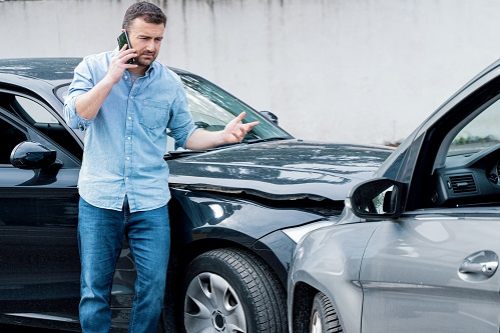- How much car insurance do you need?
- State minimum car insurance requirements: A starting point
- What are the types of car insurance coverage and how much do you need?
- How much car insurance do experts recommend?
- Average cost of car insurance by state and coverage level
- Methodology
- FAQ: Choosing car insurance coverage
How much car insurance do you need?
How much auto insurance coverage you need depends on your vehicle, your financial status, your state, and what you want from coverage.
Liability insuranceLiability insurance covers sums that an insured becomes legally obligated to pay because of bodily injuries or property damage, or financial losses caused to other people. is the foundation of a car insurance policy, and it’s required by law in most states. Some states require additional coverage, including uninsured motorist insurance and personal injury protection.
If you have a loan or lease, you’re required to carry comprehensive and collision coverageCollision coverage helps pay for repairs or replacement of your car if it's damaged in an accident, regardless of who is at fault and is subject to a deductible.; along with state requirements, that’s known as full coverage. Even if you own your car outright, you should carry full coverage if you can’t afford to repair or replace your car out-of-pocket.
There are a lot of coverage options you can add for more protection, and you can increase your coverage limits, too. To find out how much car insurance you need, it’s important to understand how each coverage works and think about your personal financial situation.
State minimum car insurance requirements: A starting point
Each state defines the minimum amount of coverage you require just to be on the road legally. These coverages are a starting point but are rarely enough coverage to really protect you on the road. In addition, there are no state requirements that provide protection against damage to your car.
| State | Minimum liability coverage limits | Other types of insurance required (if any) |
|---|---|---|
| Alaska | 50/100/25 | - |
| Alabama | 25/50/25 | - |
| Arkansas | 25/50/25 | - |
| Arizona | 25/50/15 | - |
| California | 30/60/15 | - |
| Colorado | 25/50/15 | - |
| Connecticut | 25/50/25 | UIMBI and UMBI |
| Washington, D.C. | 25/50/10 | UMBI and UMPD |
| Delaware | 25/50/10 | - |
| Florida | 10/20/10 | PIP |
| Georgia | 25/50/25 | - |
| Hawaii | 20/40/10 | PIP |
| Iowa | 20/40/15 | - |
| Idaho | 25/50/15 | - |
| Illinois | 25/50/20 | UMBI |
| Indiana | 25/50/25 | - |
| Kansas | 25/50/25 | UMBI and PIP |
| Kentucky | 25/50/25 | PIP |
| Louisiana | 15/30/25 | - |
| Massachusetts | 20/40/5 | UIMBI, UMBI, PIP and Mandatory BI |
| Maryland | 30/60/15 | UMBI, UMPD and PIP |
| Maine | 50/100/25 | UMBI and Med |
| Michigan | 50/100/10 | PIP and Property Protection |
| Minnesota | 30/60/10 | UIMBI, UMBI and PIP |
| Missouri | 25/50/25 | UMBI |
| Mississippi | 25/50/25 | - |
| Montana | 25/50/20 | - |
| North Carolina* | 30/60/25 | UMBI and UMPD |
| North Dakota | 25/50/25 | UIMBI, UMBI and PIP |
| Nebraska | 25/50/25 | UIMBI and UMBI |
| New Hampshire | 25/50/25 | UIMBI, UMBI and Med |
| New Jersey | 30/70/35 | UIMPD, UMBI, UMPD and PIP |
| New Mexico | 25/50/10 | - |
| Nevada | 25/50/20 | - |
| New York | 25/50/10 | UIMBI, UMBI and PIP |
| Ohio | 25/50/25 | - |
| Oklahoma | 25/50/25 | - |
| Oregon | 25/50/20 | UMBI and PIP |
| Pennsylvania | 15/30/5 | PIP |
| Rhode Island | 25/50/25 | - |
| South Carolina | 25/50/25 | UMBI and UMPD |
| South Dakota | 25/50/25 | UIMBI and UMBI |
| Tennessee | 25/50/25 | - |
| Texas | 30/60/25 | - |
| Utah | 30/65/25 | PIP |
| Virginia | 50/100/25 | UMBI and UMPD |
| Vermont | 25/50/10 | UIMBI, UMBI and UMPD |
| Washington | 25/50/10 | - |
| Wisconsin | 25/50/10 | UMBI |
| West Virginia | 25/50/25 | UIMBI, UIMPD, UMBI and UMPD |
| Wyoming | 25/50/20 | - |
What does it mean to have coverage limits of 15/30/5?
In this case the numbers refer to:
- Bodily injury liability coverage of $15,000 per person.
- Bodily injury liability coverage of $30,000 per accident.
- Property damage liability coverage of $5,000 per accident.
As you can see, these limits are very low and won't provide much protection. A policy with these limits provides no protection for you or your car, and only pays out for damage or injuries to others.
What are the types of car insurance coverage and how much do you need?
There are a lot of different types of car insurance coverage. Some are considered part of a basic policy, others part of a full coverage policy and yet others are add-on options you can pick and choose. To make sure you have enough coverage, it’s important to understand what those coverages are and how much you need.
Car insurance coverage that may be required
Let’s start by looking at the car insurance coverages that may be required either by law or by your lender if you financed your car.
Liability
One of the most important types is liability insurance, mandatory coverage in nearly every state. The two types of liability coverage included in auto insurance policies are:
- Bodily injury (BI). Pays for injuries you cause to others in an accident.
- Property damage (PD). Pays for damage to others’ property you cause in an accident.
Liability limits are written like this: 50/100/50. In this example, the coverage limits are $50,000 per person for bodily injury, $100,000 per incident for bodily injury, and $50,000 per incident for property damage. Many states’ minimum limits are much lower than this.
How much liability coverage you need depends on a lot of factors, but experts recommend at least 100/300/100 for most people.
Uninsured/underinsured motorist (UM/UIM)
Uninsured motorist coverage reimburses you when an uninsured motorist causes an accident or when you’re involved in a hit-and-run accident.
"This is usually an affordable coverage to add on and a great way to further protect yourself from others on the road," suggests Tiffany Lemke, senior manager of Customer Experience for Metromile.
Your limits should match your liability limits for this coverage.
Personal injury protection (PIP) and medical payments (MedPay)
Personal injury protection pays your medical bills and other related costs regardless of fault in an accident. It’s required in some states, but not offered in all.
"For those who live in a no-fault state, personal injury protection coverage extends to you and passengers in your vehicle. It covers you regardless of fault and is primary coverage -- meaning you must submit your medical bills to your car insurance provider first," says Damico.
How much PIP coverage you need depends on state laws and also your health insurance. If you have good health insurance, you may be ok with a minimum amount of PIP.
Collision and comprehensive
Collision and comprehensive coverage both pay for damage to your car but from different sources.
Collision coverage pays for repairing or replacing your vehicle if you crash into another vehicle or object or in a single-car accident.
Comprehensive insurance, also optional, "provides coverage against theft and damage caused by an incident other than a collision, such as theft, vandalism, fire, flood, hail, falling rocks or trees, and other non-collision hazards," says Mark Friedlander, director of corporate communications for the Insurance Information Institute.
You don’t have to choose the amount of coverage since it’s based on the value of your car, but you will choose the deductibleThe deductible is the amount you pay out of pocket for a covered loss when you file a claim.. A higher deductible means lower rates, but you need to be sure you can pay it, so choose wisely. This coverage is required if you have a loan or lease.
Car insurance coverage that’s always optional
There are other types of auto insurance coverage that aren’t mandatory but are often recommended. Consider your personal needs when adding options; many are low-cost and provide extra peace of mind.
Roadside assistance
Roadside assistance provides towing or help on the side of the road if something goes wrong, like a flat tire or dead battery. You can add roadside emergency assistance for a small amount, usually only a few dollars a month. It’s generally more affordable than a motor club membership.
Rental reimbursement
Rental reimbursement covers the cost of a rental vehicle while your car is being repaired, as long as it’s for a covered claim.
Gap insurance
"Gap insurance covers the difference between a car's actual cash value when it is stolen or wrecked and the amount the consumer owes the leasing or finance company," says Friedlander.
If you finance or lease your vehicle, you may be required to purchase gap insurance. If the debt you owe on a lease or loan is more than your vehicle is worth, getting gap insurance is a smart choice.
Accident forgiveness
Many carriers offer accident forgiveness coverage, which may prevent your auto premium from going up as a result of being involved in an at-fault accident (usually your first accident).
Full glass replacement
Although comprehensive insurance covers glass, you might be able to add full glass replacement coverage, which pays to repair or replace auto glass with no deductible.
How much car insurance do experts recommend?
While no one wants to overpay for coverage they don’t really need, it’s rare that extra car insurance is a bad investment, especially when it comes to liability insurance. In a serious accident, state minimum liability limits will be met and exceeded very quickly. Even a moderate accident can leave you with bills.
Some states have property damage limits as low as $5,000-$10,000. That’s not nearly enough when you consider the average cost of a new car is over $40,000 according to Kelley Blue Book. If you’re responsible for totaling a new car, you could be in real trouble with state minimum coverage.
When it comes to optional coverage, it’s best to weigh your financial resources. As a general rule, if you can’t afford the potential out-of-pocket cost without insurance, you should buy the coverage.
Average cost of car insurance by state and coverage level
Michigan, at $3,141, and California, at $2,601 are the most expensive states for full coverage car insurance; Michigan is also the most expensive state for minimum coverage with an average annual rate of $1,855. It's well ahead of the next most expensive state, which is Connecticut at $891 a year.
South Dakota has the cheapest state minimum coverage at $323 a year, followed by Iowa at $326 a year. The cheapest state for full coverage is Maine, at an average of $1,080 a year, with New Hampshire just behind it at $1,086.
For comparison, here are the average car insurance costs by state for both full coverage at 100/300/100 with $500 deductibles and state minimum liability coverage.
| State | State minimum average annual premium | Full coverage average annual premium |
|---|---|---|
| Alabama | $514 | $2,107 |
| Alaska | $415 | $2,215 |
| Arizona | $662 | $2,333 |
| Arkansas | $503 | $2,723 |
| California | $751 | $3,010 |
| Colorado | $547 | $3,222 |
| Connecticut | $1,039 | $2,726 |
| Delaware | $1,277 | $3,097 |
| Florida | $1,208 | $3,852 |
| Georgia | $780 | $2,739 |
| Hawaii | $425 | $1,721 |
| Idaho | $423 | $1,791 |
| Illinois | $462 | $1,901 |
| Indiana | $445 | $1,856 |
| Iowa | $330 | $2,228 |
| Kansas | $520 | $2,410 |
| Kentucky | $708 | $2,976 |
| Louisiana | $993 | $4,180 |
| Maine | $377 | $1,701 |
| Maryland | $815 | $2,273 |
| Massachusetts | $621 | $2,430 |
| Michigan | $714 | $3,146 |
| Minnesota | $585 | $2,561 |
| Mississippi | $510 | $2,455 |
| Missouri | $544 | $2,410 |
| Montana | $422 | $2,541 |
| Nebraska | $369 | $2,387 |
| Nevada | $908 | $3,284 |
| New Hampshire | $447 | $1,650 |
| New Jersey* | $1,124 | $2,736 |
| New Mexico | $475 | $2,486 |
| New York | $1,070 | $2,898 |
| North Carolina | $644 | $2,587 |
| North Dakota | $354 | $2,079 |
| Ohio | $390 | $1,739 |
| Oklahoma | $452 | $2,705 |
| Oregon | $715 | $1,927 |
| Pennsylvania | $421 | $2,428 |
| Rhode Island | $761 | $2,706 |
| South Carolina | $682 | $2,367 |
| South Dakota | $382 | $2,635 |
| Tennessee | $515 | $2,214 |
| Texas | $620 | $2,631 |
| Utah | $708 | $2,250 |
| Vermont | $299 | $1,504 |
| Virginia | $528 | $1,837 |
| Washington | $490 | $2,175 |
| Washington, D.C. | $896 | $3,394 |
| West Virginia | $577 | $2,557 |
| Wisconsin | $407 | $2,026 |
| Wyoming | $286 | $1,984 |
*Rates reflect 2025 minimum limits and will be updated as soon as data is available.
Methodology
We partnered with Quadrant Information Services to field average car insurance rates across all 50 states and Washington, D.C. National and state average rates are based on three coverage levels: state minimum, 50/100/50 liability-only, and full coverage with 100/300/100 liability and $500 deductibles.
Unless otherwise indicated, averages are based on our full coverage data set. This data set is based on:
- 12-mile commute, 10,000 annual mileage
- Bodily injury liability of $100,000 per person and $300,000 per incident
- Property damage liability of $100,000 per incident
- Comprehensive and collision deductibles of $500
- 40-year-old driver
- Honda Accord LX
- Good credit
- A clean driving record
Learn more about our data and methodology.
FAQ: Choosing car insurance coverage
How much personal injury protection do I need?
If you have good health insurance, you can probably get away with state minimum personal injury protection. If not, consider increasing the limits as high as you can afford to go.
How much medical payments coverage do I need?
For most people, medical payments coverage at the amount required by law is sufficient. If you lack good health insurance, consider increasing it.
What deductible should I choose for car insurance?
Choose a deductible that you can afford to pay in the event of a claim against your collision or comprehensive coverage. Deductibles range from $250 to $2,000, although some insurance companies offer higher or lower options.
"The deductible level you choose is a personal choice based on your financial situation. If you can afford a higher deductible, it will reduce your premium," Friedlander says.



